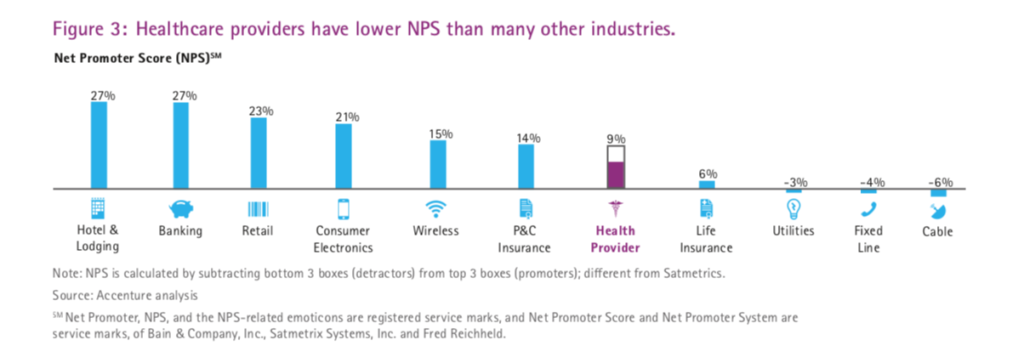Attracting and retaining customers isn’t as easy as it used to be. Healthcare consumers have more information and more choices than ever without any loyalty except to the best deal.
Pew Research reports that the majority of consumers begin their search for information online. They use Google to search for different industry terms like short term health insurance, industry-specific sites such as Fortune, and on your own web pages.
So consider these four questions:
- Are your doctors easy to find online?
- Is all the information on your web pages and profiles correct and up to date?
- Do your providers have great ratings and reviews?
- Where are the referrals?
Digital capabilities — electronic health records, consumer portals and online appointment scheduling, for example — are improving at a blistering pace. As they do, it becomes ever faster and easier for patients to locate providers. Which means your challenge to remain visible is intensifying.
Here are the top reasons potential customers can pass you by and choose a competing provider:
1. It’s hard to find you online and when they do your listings are outdated.
Accurate business listings for your providers and locations — on major search engines, industry-specific sites such as Healthgrades and Vitals, as well as your website — are critical to attracting new patients.
Pew Research reports 77 percent of health seekers start online with Google or other major search engines and displaying the most recent information is essential. Placable found 73 percent of people lose trust in a local business if its business listing has inaccuracies, and 67 percent lose trust in a business if they get lost because the address listed online is wrong.
Yet for large health systems with hundreds or thousands of affiliated doctors and physicians, keeping listings accurate on your website and across the web can be extremely difficult — if not outright impossible. Not only is physician data constantly in flux, but data may be coming from multiple, disparate sources. This makes it difficult to connect patients to the right healthcare services and creates frustration for your patients, and lost revenue for your organization.
Devoting staff to updating and optimizing physician sites is a costly, time-consuming endeavor. But without a single source of truth, missing or inaccurate listings — and bad patient experiences — are inevitable.
2. Ratings and reviews are not on your website.
A recent Reputation.com survey revealed 80 percent of consumers say ratings and reviews strongly influence their choice of provider. And according to Software Advice, 47 percent of consumers say positive online reviews would persuade them to choose a doctor who’s out-of-network.
Those are undeniable statistics. If the physician profiles on your website don’t display ratings and reviews, you’re not providing the information patients need to choose you over a competitor.
3. You make it difficult to schedule an appointment.
Healthcare seekers now expect a consumer-like experience when choosing a healthcare provider. Apps like OpenTable allow you to book a dinner reservation at your favorite restaurant right away. If you’re not taking advantage of technologies available to create a smooth, seamless digital user experience, you’re at a disadvantage.
Patients should be able not only to find a provider, but to read reviews from other patients and immediately schedule an appointment — all in the same place.
Directing them to another website for scheduling or requiring that they call for an appointment introduces another layer of friction in the customer acquisition cycle— and an opportunity for them to take an easier route with a competitor.
4. Where are the patients referrals going?
Switching healthcare is hard—but made easier with digital health tools.
Many healthcare consumers stay with their providers because they think it would be hard to leave, not because they are loyal. In fact, 40 percent of healthcare consumers say that switching is a hassle, second only to gas and electric utility companies.
Digital health capabilities such as electronic health records, consumer portals and online appointment scheduling increase health data sharing, healthcare price transparency and information access. Virtual health—including video appointments and e-visits—introduces convenient, personalized care options that depend less on in-person interactions.
As these digital health experiences and capabilities become more prevalent, it will become easier for patients to switch providers and flee to other doctors or hospitals in even greater numbers. Healthcare providers need to prepare now to combat this disruption and start implementing cross-industry loyalty strategies to earn their patients’ loyalty.
Accenture research shows that 44 percent of consumers choose their healthcare provider based on a recommendation. Many such recommendations come from other doctors.
What if a doctor in your system refers a patient to a specialist he or she knows who is outside your system, because it’s easier than searching for a physician within your network? It’s likely that patient will accept the recommendation and exit your system, and you’ll lose their business.
But if it’s easy for your doctors to refer patients to other providers within your system, they will — and patients won’t be sent to competitors.
A New Kind of Digital Engagement
Rather than being disrupted, healthcare providers can be the disruptors. They can use digital health capabilities to drive patient loyalty and growth.
This new kind of digital patient engagement requires a new mindset and a new toolset. To achieve this, healthcare providers must focus on three key imperatives:
1. Give consumers reasons to stay
Take steps to profile and target consumers to offer the experiences they crave. This includes easing appointment access
via online and call center scheduling, appointment delivery via in-person or virtual visits and personalized follow up via EMR or texted instructions.
2. Eliminate the Barriers – make it easy to choose YOU
The best strategy for competitive success is to make it as easy for patients to find, select and book appointments with you as possible. Reputation.com’s Healthcare Directory eliminates the barriers to patient acquisition and retention with an integrated directory solution that:
- Provides a single source of truth for managing physician and location data.
- Ensures consistency between internal data and third-party listings across the web.
- Incorporates online ratings and reviews, surveys and scheduling on physician pages.
- Simplifies in-house referrals and helps doctors connect patients with the right providers.
3. Earn and enable consumer recommendations
Communicate and reinforce service strengths while listening and integrating to consumers’ improvement suggestions. Make it easy to post reviews and ratings to reach others through digital channels and social media. Enlist others to advocate, share and post about the health system. Provide channels for patients’ friends and
families, referring providers, staff and allied professionals to endorse, refer and recommend. Design first-time experiences that include getting to know consumers personally, then follow up with tailored outreach and seamless record transfers and scheduling.




